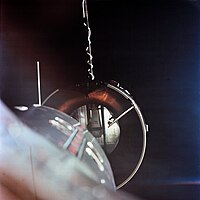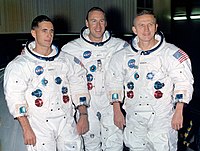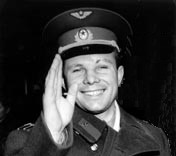A | B | C | D | E | F | G | H | CH | I | J | K | L | M | N | O | P | Q | R | S | T | U | V | W | X | Y | Z | 0 | 1 | 2 | 3 | 4 | 5 | 6 | 7 | 8 | 9

Records and firsts in spaceflight are broadly divided into crewed and uncrewed categories. Records involving animal spaceflight have also been noted in earlier experimental flights, typically to establish the feasibility of sending humans to outer space.
The notion of "firsts" in spaceflight follows a long tradition of firsts in aviation, but is also closely tied to the Space Race. During the 1950s and 1960s, the Soviet Union and the United States competed to be the first countries to accomplish various feats. In 1957, the Soviet Union launched Sputnik 1, the first artificial orbital satellite. In 1961, Soviet Vostok 1 cosmonaut Yuri Gagarin became the first person to enter space and orbit the Earth, and in 1969 American Apollo 11 astronaut Neil Armstrong became the first person to set foot on the Moon. No human has traveled beyond low Earth orbit since 1972, when the Apollo program ended.
During the 1970s, the Soviet Union directed its energies to human habitation of space stations of increasingly long durations. In the 1980s, the United States began launching its Space Shuttles, which carried larger crews and thus could increase the number of people in space at a given time. Following their first mission of détente on the 1975 Apollo-Soyuz Test Project, the Soviet Union and the United States again collaborated with each other on the Shuttle-Mir initiative, efforts which led to the International Space Station (ISS), which has been continuously inhabited by humans for over 20 years.
Other firsts in spaceflight involve demographics, private enterprise, and distance. Dozens of countries have sent at least one traveler to space. In 1963, Valentina Tereshkova became the first woman in space, aboard Vostok 6. In the early 21st century, private companies joined government agencies in crewed spaceflight: in 2004, the sub-orbital spaceplane SpaceShipOne became the first privately funded crewed craft to enter space; in 2020, SpaceX's Dragon 2 became the first privately developed crewed vehicle to reach orbit when it ferried a crew to the ISS. As of 2024, the uncrewed probe Voyager 1 is the most distant artificial object from the Earth, part of a small class of vehicles that are leaving the Solar System.
First independent suborbital and orbital human spaceflight by country
| Country | Mission | Crew | Spacecraft | Launch vehicle | Date | Type |
|---|---|---|---|---|---|---|
| Vostok 1[1] | Yuri Gagarin[1] | Vostok 3KA[1] | Vostok-K[1] | 12 April 1961[1] | Orbital[1] | |
| Mercury-Redstone 3 (Freedom 7)[2] | Alan Shepard[2] | Mercury Spacecraft No.7[2] | Mercury-Redstone[2] | 5 May 1961[2] | Sub-orbital[2] | |
| Mercury-Atlas 6 (Friendship 7)[3] | John Glenn[3] | Mercury Spacecraft No.13[3] | Atlas LV-3B | 20 February 1962[3] | Orbital[3] | |
| Soyuz 18A | Vasily Lazarev, Oleg Makarov | Soyuz 7K-T | Soyuz 11A511 | 5 April 1975 | Sub-orbital | |
| Soyuz TM-14 | Aleksandr Viktorenko, Aleksandr Kaleri, Klaus-Dietrich Flade | Soyuz-TM | Soyuz-U2 | 17 March 1992 | Orbital | |
| Shenzhou 5[4] | Yang Liwei[4] | Shenzhou spacecraft[4] | Long March 2F[4] | 15 October 2003[4] | Orbital[4] | |
| Soyuz MS-10 | Aleksey Ovchinin, Nick Hague | Soyuz-MS | Soyuz-FG | 11 October 2018 | Sub-orbital |
Human spaceflight firsts
This section needs additional citations for verification. (June 2015) |
Note: Some space records are disputed as a result of ambiguities surrounding the border of space. Most records follow the FAI definition of the space border which the FAI sets at an altitude of 100 km (62.14 mi). By contrast, the NASA-, USAF- and FAA-defined border of space is at 50 mi (80.47 km).
| First | Person(s) | Mission | Country | Date |
|---|---|---|---|---|
| Yuri Gagarin | Vostok 1[5] | 12 April 1961 | ||
|
Alan Shepard | Freedom 7 | 5 May 1961 | |
|
Gherman Titov | Vostok 2 | 6 August 1961 – 7 August 1961 | |
|
12 August 1962 – 15 August 1962 | |||
|
Valentina Tereshkova | Vostok 6[9] | 16 June 1963 – 19 June 1963 | |
|
Joe Walker | X-15 Flight 90 | 19 July 1963 | |
| Person to enter space twice (suborbital flights above 100 kilometres (62 mi)) | Joe Walker | X-15 Flights 90 and 91 | 22 August 1963 | |
|
Voskhod 1[5] | 12 October 1964 – 13 October 1964 | ||
| Spacewalk | Alexei Leonov | Voskhod 2[5] | 18 March 1965 | |
| Orbital maneuvers (change orbit) | Gus Grissom, John W. Young | Gemini 3[5] | 23 March 1965 | |
| Person to fly two orbital spaceflights | Gordon Cooper |
| ||
| Persons to spend one week in space | Gemini 5 | 21 August 1965 – 29 August 1965 | ||
|
15 December 1965 – 16 December 1965 | |||
| Civilian in orbit (at the time of flight) | Neil Armstrong | Gemini 8 | 16 March 1966 – 17 March 1966 | |
Space docking |
Gemini 8 and Agena[5] | 16 March 1966 | ||
| Multiple (dual) rendezvous (with Agena 10, then Agena 8)[10] | Gemini 10 |
| ||
| Persons to exceed 1,000 km above Earth | Gemini 11 | 12 September 1966 –
15 September 1966 | ||
| Spaceflight death (during landing) | Vladimir Komarov | Soyuz 1 | 23 April 1967 – 24 April 1967 | |
|
Walter Schirra | 22 October 1968 | ||
 |
Apollo 8 | 24 December 1968 – 25 December 1968 | ||
|
>Text je dostupný pod licencí Creative Commons Uveďte autora – Zachovejte licenci, případně za dalších podmínek. Podrobnosti naleznete na stránce Podmínky užití. Zdroj: Wikipedia.org - čítajte viac o List of spaceflight records
Text je dostupný za podmienok Creative
Commons Attribution/Share-Alike License 3.0 Unported; prípadne za ďalších
podmienok. |


